Texas Governor Thomas Mitchell Campbell Governor Thomas Mitchell Campbell
-
- Texas Governor Thomas Mitchell Campbell
- (1856-1923)
- In Office 1907-1911 from Palestine Texas
- Image Size: 24 x 20
- Frame Size: 34 x 30
- Medium: Hand Tinted Early Photograph
- Circa late 1800s
- Governor Thomas Mitchell Campbell
- Contact for Price & Info
- View All By This Artist
Details
Sorry about the poor photos. The reflection in the glass made it difficult to photograph. We also have a large portrait of Mrs. Campbell. This large original photograph is housed in a spectacular hand carved frame.
Life
Campbell was born in Rusk in Cherokee County in East Texas, the son of Thomas Duncan and Rachel (Moore) Campbell. He attended school at Rusk and entered Trinity University in 1873 to study law. He was unable to support himself and withdrew after a year. Campbell went to work in the Gregg County clerk's office and continued his studies at night. In 1878, he was admitted to the Texas bar. In the same year, he married Fannie Irene Bruner of Shreveport, Louisiana, whose father, William Bruner, was a Mississippi captain in the Confederate States Army and thereafter a landholder and city comptroller in Shreveport.
Campbell practiced law in Longview until he became involved with the troubled International-Great Northern Railroad in 1889. He became its court-appointed receiver in 1891 and moved his family to Palestine. The next year, after lifting the line from bankruptcy, he remained in Palestine as the general manager of the railroad.Political career
Campbell distrusted monopolistic big business and sympathized with trade unions. He shared many of the reformist political views of former Texas governor James Stephen Hogg. In 1897, Campbell resigned from the railroad and became active in Democratic Party politics. At Hogg's urging, he decided to run for governor.
Campbell was elected governor in 1906. In his two terms in office, 1907-1911, Campbell initiated a number of reforms involving railroad regulation, equitable taxation, and lobbying restrictions. In 1907, he named the legendary Captain Bill McDonald of the Texas Rangers as the state revenue agent. During his two-year appointment, McDonald increased the state's valuation by a nearly a billion dollars.[1] The most significant legislation centered on prison reform, as Campbell's administration ended the contract lease system for inmates and implemented more humane treatment of prisoners. Under Campbell, many state agencies also came into being, including the Department of Insurance and Banking, the Bureau of Labor Statistics, the State Board of Health, and the Texas State Library.
Campbell returned to private law practice in Palestine, but remained active in Democratic politics. In 1916, he ran unsuccessfully against his fellow Democrat Charles Culberson for the United States Senate.
He died in Galveston and is interred in Palestine, Texas, where his grave is marked with a tall white obelisk.[2]
-
-
Biography
Texas Governor Thomas Mitchell Campbell (1856-1923)
Thomas Mitchell Campbell
24th Governor of Texas
In office
January 15, 1907 – January 17, 1911
Lieutenant
Asbury Bascom Davidson
Preceded by
S. W. T. Lanham
Succeeded by
Oscar Branch ColquittPersonal details
Born
April 22, 1856 Rusk, Texas
Died
April 1, 1923 (aged 66)
Galveston, TexasNationality
American
Political party
DemocraticSpouse(s)
Fannie Irene BrunerChildren
5
Parents
Thomas Duncan and Rachel Moore Campbell
Cynthia Divernia Carroll Campbell (stepmother)
Thomas Mitchell Campbell (April 22, 1856 – April 1, 1923) was the 24th Governor of Texas from 1907 to 1911.Life[edit]
Campbell was born in Rusk in Cherokee County in East Texas, the son of Thomas Duncan and Rachel (Moore) Campbell. He attended school at Rusk and entered Trinity University in 1873 to study law. He was unable to support himself and withdrew after a year. Campbell went to work in the Gregg County clerk's office and continued his studies at night. In 1878, he was admitted to the Texas bar. In the same year, he married Fannie Irene Bruner of Shreveport, Louisiana, whose father, William Bruner, was a Mississippi captain in the Confederate States Army and thereafter a landholder and city comptroller in Shreveport.
Campbell practiced law in Longview until he became involved with the troubled International-Great Northern Railroad in 1889. He became its court-appointed receiver in 1891 and moved his family to Palestine. The next year, after lifting the line from bankruptcy, he remained in Palestine as the general manager of the railroad.Political career[edit]
Campbell distrusted monopolistic big business and sympathized with trade unions. He shared many of the reformist political views of former Texas governor James Stephen Hogg. In 1897, Campbell resigned from the railroad and became active in Democratic Party politics. At Hogg's urging, he decided to run for governor.
Campbell was elected governor in 1906. In his two terms in office, 1907-1911, Campbell initiated a number of reforms involving railroad regulation, equitable taxation, and lobbying restrictions. In 1907, he named the legendary Captain Bill McDonald of the Texas Rangers as the state revenue agent. During his two-year appointment, McDonald increased the state's valuation by a nearly a billion dollars.[1] The most significant legislation centered on prison reform, as Campbell's administration ended the contract lease system for inmates and implemented more humane treatment of prisoners. Under Campbell, many state agencies also came into being, including the Department of Insurance and Banking, the Bureau of Labor Statistics, the State Board of Health, and the Texas State Library.
Campbell returned to private law practice in Palestine, but remained active in Democratic politics. In 1916, he ran unsuccessfully against his fellow Democrat Charles Culberson for the United States Senate.
He died in Galveston and is interred in Palestine, Texas, where his grave is marked with a tall white obelisk.[2]



